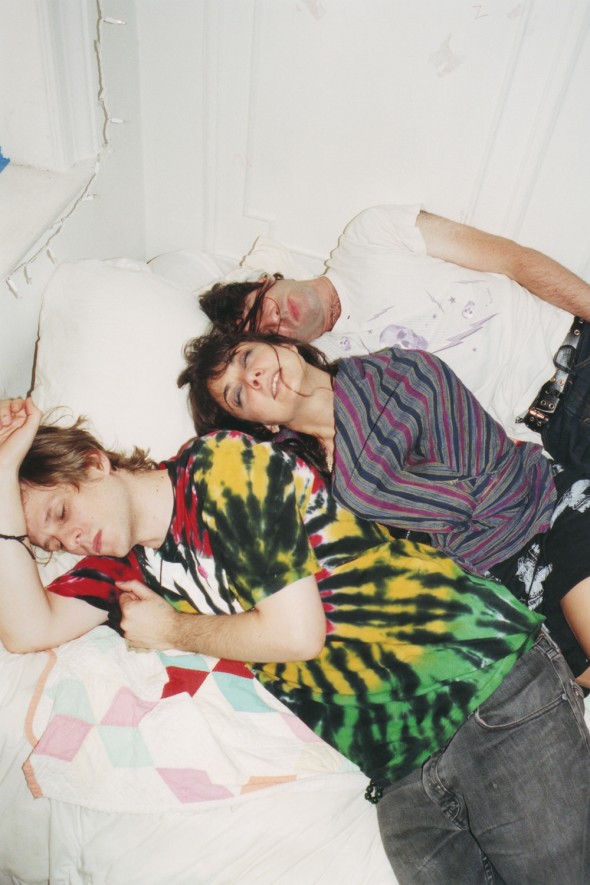
Photography by Colin Dodgson
The band Gang Gang Dance (GGD) is like a thunderstorm: dramatic, powerful, and energized. After a build up, when voltage accrues and focuses, lightning strikes. Sometimes the effects are beautiful, and other times they are completely devastating.
Explosions have defined the band’s musical evolution. Lightning killed an original member; a recent tour fire destroyed all their equipment and—let it be noted—their sound can at times be as ethereal as raindrops and as chaotic as a hurricane. GGD’s otherworldly configurations, both in their sound and in their outlook, appear to be influenced more by color, light, and atmosphere than anything else. Lizzi Bougatsos, GGD’s fiery vocalist, says the band’s relationship with light will “hopefully deepen our connections with the earth and our ancestors.” She adds, “Our dialogue with music in the past 10 years has been very expansive and global.”
GGD, New York’s tribal-psychedelic art-band, is a four-piece outfit employing traditional rock instruments, but sounding everything except traditional, and nowhere near rock. Bougatsos is as close to a lead singer as the group has; but because of her striking Greek-American beauty, her effervescent personality, and how she holds the microphone in true pop star fashion, she has become somewhat of a spokeswoman. Brian Degraw is the keyboardist and visual artist of GGD, having designed all their album covers. Bougatsos calls him “The Thinker” like Auguste Rodin’s famous sculpture. Guitarist, Josh Diamond, is what Bougatsos calls, “The Encyclopedia” based on his extensive knowledge of African music.
GGD formed nearly ten years ago, but, as Degraw puts it, “No one actually remembers when we started. We would get together, usually at a show and play music together in front of people,” referring to the loose-knit, and improvisational beginnings.
Original percussionist and singer, Nathan Maddox, who Diamond calls, “The most free-spirited guy any of us had ever known,” was fundamental to GGD’s origins, and his memory continues to fuel the band. Maddox was struck by lightning on a Chinatown rooftop in 2002, after allegedly offering himself to the storm. “We believe that he wanted to be taken,” says Bougatsos. “After Nathan passed away, we started practicing more without discussing it,” Diamond adds. “He’s still here in our music.”
With Tim Dewit as their new percussionist, the quartet has released four albums and two EPs on the independent label The Social Registry. After their most recent album Saint Dymphna, Dewit decided to take a break from the band and Jesse Lee now plays drums in his place.
Despite clear roots in Downtown Manhattan (members of the band have lived, played, worked, and exhibited art on and off there), the band is hesitant to embrace a relationship to local musical communities. They have always been the kind of group that fell on the musical genre sidelines with acts such as Animal Collective and Black Dice, with whom they previously shared a Williamsburg practice space.
The band’s fine art résumé spans from LA to Oslo, and both Bougatsos and Degraw regularly show their work at galleries. But Degraw refused to claim any relationship to the New York art scene either. “A few years ago I consciously stopped going to galleries,” he says. “I felt like I didn’t want any subconscious infiltration or influence creeping into what I do. I have been choosing to draw inspiration from other things outside paintings and other typical forms of art. I’m trying to find the same sort of inspiration in nature and space.”
Diamond interrupts, “What little there is around here.” Degraw takes a moment and points upward and says, “Well, there is outer space.”
GGD has performed at such prestigious events at the Whitney Biennial in 2008 and this year’s MOMA Armory after-party. While these are esteemed venues, the band treats performing at the Whitney Biennial like any other show. Degraw says, “It was on the same level of importance as playing a basement in Ohio. I don’t like to make a hierarchy of places that art exists in.”
Influence is not a word GGD likes to use—they prefer alchemy. “Art mixes naturally with our music,” says Diamond. “It’s a very natural integration. You can see it. We paint with sounds. Each sound represents a color.” GGD’s music is more of a spiritual than intellectual endeavor as well. For Degraw, the relationship between sound and color is even more heightened and confused. He says, “With music I see visual things. That’s when it’s the best for me…when I am able to see the sound.”
Psychic purity is of utmost importance to the band, and to assist with that, GGD has a spiritual adviser or what they sometimes call their “vibe-man” Taka. “Sometimes he’s not even really on stage, sometimes he stands in front and makes sure we’re really vibing,” adds Degraw. “We told him that we really like to see him when we play. Sometimes he’ll stand there and let us look at him. It really works. Sometimes he even has headphones in and is listening to other music.”
Taka was not there a few months ago, when all the band’s gear caught fire at a club in Amsterdam. They have a sneaking suspicion that the incident probably would not have happened if Taka was around. Still, GGD was able to find something positive in the smoldering equipment, the melted memory cards, and the cancelled tour. “It was devastating when it happened. It was also a blessing; a reminder that there are larger forces out there,” Diamond says.
“The first show we played when we replaced our stuff was so triumphant. We borrowed all this gear from friends and, personally, I didn’t know how to use the most of the equipment,” said Bougatsos. “It was nerve-wracking, but it was probably my favorite show. It was like our early performances where you put yourself out there and you don’t know what’s going to happen. That’s when you really travel.”
– Deenah Vollmer

